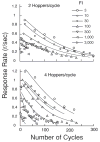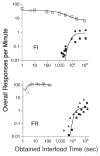Does satiation close the open economy?
- PMID: 16573210
- PMCID: PMC1456067
- DOI: 10.3758/bf03193178
Does satiation close the open economy?
Abstract
Pigeons responded on fixed-interval and fixed-ratio food schedules during sessions of extended duration. Pause lengths from the beginning of the session, when the subjects were hungry, resembled those found in open economies, whereas pause lengths from the end of the sessions, when the subjects were close to satiation, resembled those from closed economies. A model of motivation captured key features of the data, suggesting that a changing level of hunger is a causal factor in the behavioral differences observed between open and closed economies. Behavioral theories may provide a parsimonious alternative to economic theories in accounting for such effects.
Figures







Similar articles
-
Behavioral economics and within-session changes in responding.J Exp Anal Behav. 1999 Nov;72(3):355-71. doi: 10.1901/jeab.1999.72-355. J Exp Anal Behav. 1999. PMID: 10605103 Free PMC article.
-
On the distinction between open and closed economies.J Exp Anal Behav. 1987 Jul;48(1):35-60. doi: 10.1901/jeab.1987.48-35. J Exp Anal Behav. 1987. PMID: 3625103 Free PMC article.
-
The effects of component duration on multiple-schedule performance in closed and open economies.J Exp Anal Behav. 1988 Nov;50(3):457-68. doi: 10.1901/jeab.1988.50-457. J Exp Anal Behav. 1988. PMID: 3209960 Free PMC article.
-
Pause relationships in multiple and chained fixed-ratio schedules.J Exp Anal Behav. 1968 Mar;11(2):117-26. doi: 10.1901/jeab.1968.11-117. J Exp Anal Behav. 1968. PMID: 5645867 Free PMC article.
-
The effect of economy type on reinforcer value.Behav Processes. 2019 May;162:20-28. doi: 10.1016/j.beproc.2019.01.008. Epub 2019 Jan 24. Behav Processes. 2019. PMID: 30685410 Free PMC article. Review.
Cited by
-
Effect of quinolinic acid-induced lesions of the subthalamic nucleus on performance on a progressive-ratio schedule of reinforcement: a quantitative analysis.Behav Brain Res. 2008 Dec 22;195(2):223-30. doi: 10.1016/j.bbr.2008.09.005. Epub 2008 Sep 18. Behav Brain Res. 2008. PMID: 18840473 Free PMC article.
-
The effects of session length on demand functions generated using FR schedules.J Exp Anal Behav. 2011 May;95(3):289-304. doi: 10.1901/jeab.2011.95-289. J Exp Anal Behav. 2011. PMID: 21547068 Free PMC article.
-
Heroin choice depends on income level and economy type.Psychopharmacology (Berl). 2020 May;237(5):1447-1457. doi: 10.1007/s00213-020-05471-6. Epub 2020 Jan 29. Psychopharmacology (Berl). 2020. PMID: 31993695 Free PMC article.
-
The Risky Closed Economy: A Holistic, Longitudinal Approach to Studying Fear and Anxiety in Rodents.Front Behav Neurosci. 2020 Oct 23;14:594568. doi: 10.3389/fnbeh.2020.594568. eCollection 2020. Front Behav Neurosci. 2020. PMID: 33192372 Free PMC article.
-
Rats' performance in a suboptimal choice procedure implemented in a natural-foraging analogue.Anim Cogn. 2024 Nov 1;27(1):72. doi: 10.1007/s10071-024-01913-2. Anim Cogn. 2024. PMID: 39485623 Free PMC article.
References
-
- Aoyama K. Within-session response rate in rats decreases as a function of amount eaten. Physiology & Behavior. 1998;64:765–769. - PubMed
-
- Aoyama K. Effects of hunger state on within-session response decreases under CRF schedule. Learning & Motivation. 2000;31:1–20.
-
- Aoyama K, McSweeney FK. Habituation may contribute to within-session decreases in responding under high-rate schedules of reinforcement. Animal Learning & Behavior. 2001;29:79–91.
-
- Belke TW, Kwan TY. The effect of changes in availability on food selection at different levels of deprivation. Psychological Record. 2000;50:529–541.
Publication types
MeSH terms
Grants and funding
LinkOut - more resources
Full Text Sources
